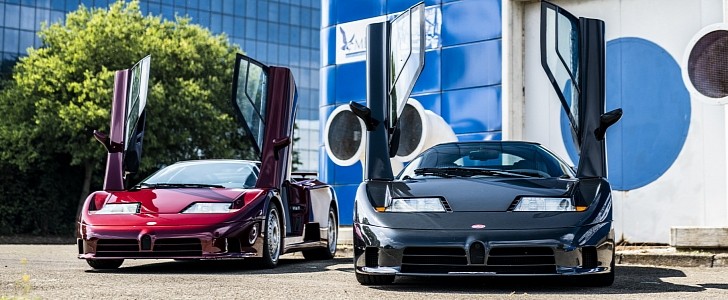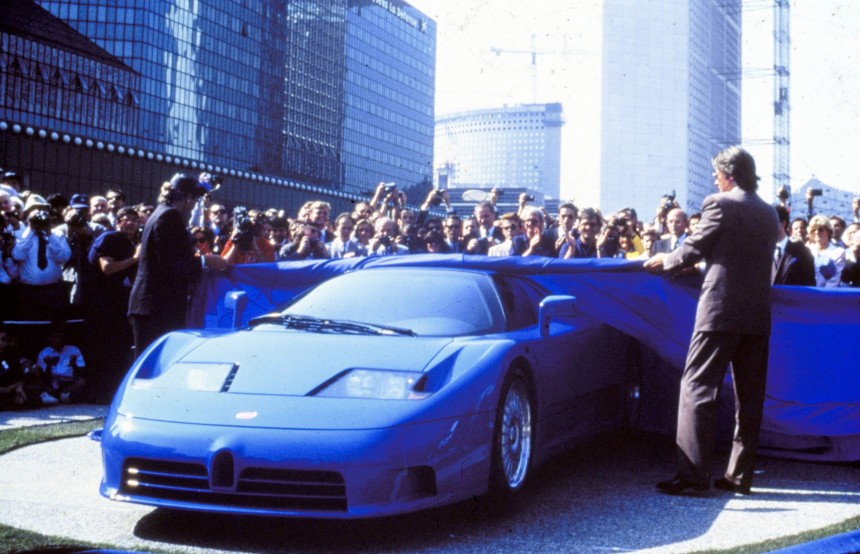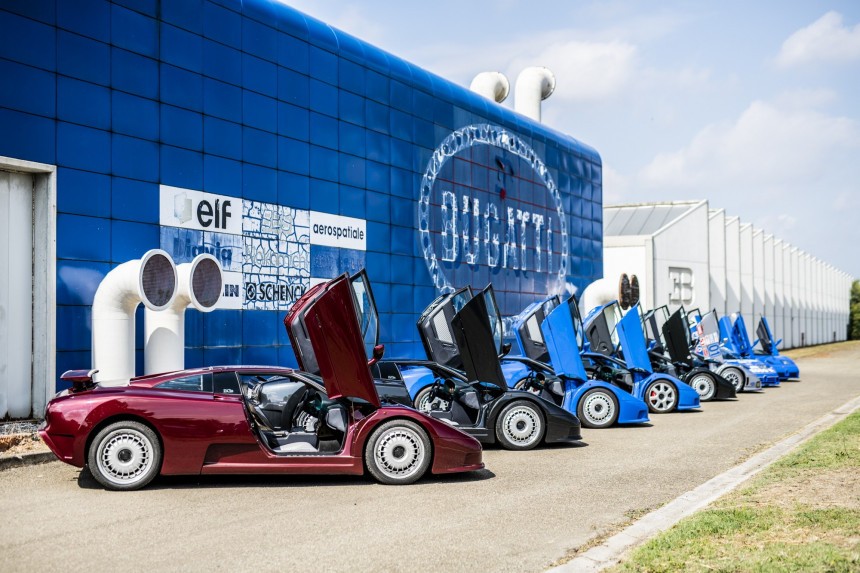Before ending up under Volkswagen Group’s cozy roof, Bugatti was revived toward the end of the 1980s by Romano Artioli. The Italian car importer bought the trademark rights of the brand that was defunct since the early 1960s in 1987, and became chairman of the new company, based in Modena, Campogalliano, Italy, back then.
Shortly after, they began working on a super sports car that would dwarf pretty much anything on four wheels in terms of power, acceleration, and top speed. The prototype was designed by the famous Marcello Gandini, and Giampaolo Benedini signed the styling of the production models that hit the assembly line in 1991 under a very special name: EB 110.
EB stands for Ettore Bugatti, who originally founded the eponymous company back in 1909, and 110 was a celebration of what would have been his 110th birthday. As the supercar world was collapsing, Bugatti made around 95 units of the EB 110 and 39 of the EB 110 Super Sport until 1995. The total production number is believed to stand at 134, including the prototypes, two of which were official factory racers that boasted 661 HP (670 PS / 493 kW).
Speaking of numbers, depending on the specification, the fabulous 3.5-liter V12 churned out between 552 and 601 HP (560-610 PS / 412-449 kW). Developed in accordance with the era’s F1 regulations, the engine featured four turbochargers and five valves per combustion chamber for a total of 60. It could hold 15 liters of oil in the dry-sump lubrication system, could be revved up to 8,250 rpm, and was mated to a six-speed manual transmission and all-wheel drive.
The stopping power was provided by the Brembo brakes, and a rear spoiler was added for improved downforce and high-speed handling, whereas the cast magnesium wheels were 18 inches in diameter, shod in 245/40 front and 325/30 rear tires.
In its most agile form, the EB 110 needed only 3.26 seconds from 0 to 62 mph (0-100 kph), and topped out at 218 mph (351 kph), a record for production cars. In total, it scored four world records, including for the fastest acceleration, fastest production sports car, and fastest production sports car to run on natural gas.
Its engine was definitely impressive for that time, and so was the carbon monocoque. Made by Aerospatiale, it tipped the scales at 275 lbs (125 kg), and was a true revolution for production cars, as the EB 110 was the first of its kind to feature one. Aluminum, carbon, and aramid fiber-reinforced plastic were chosen for the bodywork, and the screws were made of titanium.
While some of its competitors were pretty much racers with blinkers and a radio, the EB 110 was a luxury cruiser. It had high-end leather upholstery, air conditioning, premium sound system, electrically adjustable seats, central locking, and power steering. Ingress and egress were facilitated by the scissor doors.
When it left the factory floor three decades ago, the normal GT was priced at 450 million Italian lira, including servicing and parts for the first three years of ownership, and the Super Sport was sold from 550 million lira. Around 10 years ago, one could buy an EB 110 for the equivalent of almost $330,000 (€280,000), an absolute bargain compared to one that was recently sold in Monterey for almost $3 million.
The EB 110’s legacy was continued throughout the 2000s by the Veyron, which came out in the VW Group era. The hypercar was retired in 2015, and one year later, its place was taken by the Chiron and its derivatives, which, just like the Veyron, come to life at the Molsheim facility in France.
EB stands for Ettore Bugatti, who originally founded the eponymous company back in 1909, and 110 was a celebration of what would have been his 110th birthday. As the supercar world was collapsing, Bugatti made around 95 units of the EB 110 and 39 of the EB 110 Super Sport until 1995. The total production number is believed to stand at 134, including the prototypes, two of which were official factory racers that boasted 661 HP (670 PS / 493 kW).
Speaking of numbers, depending on the specification, the fabulous 3.5-liter V12 churned out between 552 and 601 HP (560-610 PS / 412-449 kW). Developed in accordance with the era’s F1 regulations, the engine featured four turbochargers and five valves per combustion chamber for a total of 60. It could hold 15 liters of oil in the dry-sump lubrication system, could be revved up to 8,250 rpm, and was mated to a six-speed manual transmission and all-wheel drive.
In its most agile form, the EB 110 needed only 3.26 seconds from 0 to 62 mph (0-100 kph), and topped out at 218 mph (351 kph), a record for production cars. In total, it scored four world records, including for the fastest acceleration, fastest production sports car, and fastest production sports car to run on natural gas.
Its engine was definitely impressive for that time, and so was the carbon monocoque. Made by Aerospatiale, it tipped the scales at 275 lbs (125 kg), and was a true revolution for production cars, as the EB 110 was the first of its kind to feature one. Aluminum, carbon, and aramid fiber-reinforced plastic were chosen for the bodywork, and the screws were made of titanium.
When it left the factory floor three decades ago, the normal GT was priced at 450 million Italian lira, including servicing and parts for the first three years of ownership, and the Super Sport was sold from 550 million lira. Around 10 years ago, one could buy an EB 110 for the equivalent of almost $330,000 (€280,000), an absolute bargain compared to one that was recently sold in Monterey for almost $3 million.
The EB 110’s legacy was continued throughout the 2000s by the Veyron, which came out in the VW Group era. The hypercar was retired in 2015, and one year later, its place was taken by the Chiron and its derivatives, which, just like the Veyron, come to life at the Molsheim facility in France.




















